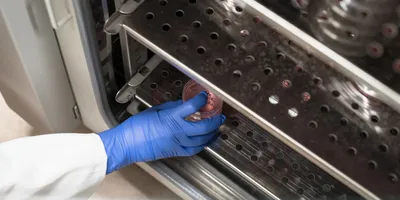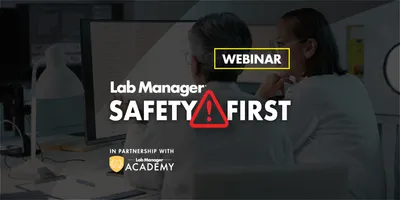In order to ensure that products going into the market meet the highest standards, many manufacturing companies have a designated division that tests the quality of its material. Brian Newell heads one such division. He is a quality services lab supervisor at Playtex Manufacturing, Inc., in Delaware, a division of the Energizer Holdings, Inc.
“Our lab is a conglomerate of a couple of different things,” Newell says. “We perform testing for the quality control of raw materials, work in process and finished goods, using validated methodologies. We work as quickly as possible so that we don’t hold up our production.”
The Energizer Battery Company produces items such as batteries, tampons, sunscreen, personal wipes and antibacterial products. Newell’s lab tests most of these products for their quality except for batteries, which are tested elsewhere.

“We test for different product lines,” he says. “For the sunscreens, we typically perform consumer complaint testing and stability shelf-life testing. For tampons, we either test the raw materials or components. For Nurser [baby bottles], we typically do spotchecks on a variety of things, and for the wet wipes, we do microbiological testing of the antibacterial products and then we also perform stability shelf-life testing.”
The testing entails a variety of checklists where Newell and his team check off key items unique to each specific product. For example, when Newell’s team tests a sunscreen or sunblock, they perform organoleptic screening, which looks at the color, odor and appearance of the material. Additionally, they look at the active ingredients, such as oxybenzone, titanium dioxide and zinc oxide.
“About 75 percent of our work is now sunscreen related; probably about 15 percent of what’s left is related to tampons—in particular the Playtex Sports and Playtex Gentle Glide products,” Newell says. “About 10 percent of our work is the Playtex Nurser testing, and we also do a little bit of testing for the Playtex Wipes product line, specifically Wet Ones.”
The Operation
Newell works in the Playtex offices in Dover, Delaware. The site encompasses about 531,500 square feet. There are four quality labs within that location, including the one that Newell is in charge of. Newell’s group takes up 5,000 square feet, including storage and offices. Newell, along with six employees, runs the lab.
“I have two people working in the microbiology lab, three people working in the analytical lab, and one stability administrator and myself,” Newell says. “I report to a senior manager. That manager then reports to a director who reports to a global director who reports to a vice president.”
Newell’s employees all have a solid science background and education. The stability administrator and the three employees working in the analytical lab are all degreed chemists, while the two staff members in the microbiology lab are degreed biologists.
Newell himself is a degreed chemist with 27 years of experience. “I’ve been in a quality environment my entire career. I was with the Perrigo Company of South Carolina, Inc. for the first 13 years, and then I moved here and have been with Playtex ever since,” he explains.
Together, the seven-person team analyzes more than 3,000 samples a year.
“Over the years we have seen the number of samples increase but the testing per sample has been very slowly decreasing,” Newell says. “To keep my group from becoming overwhelmed by the increased volume of samples, we work smarter not harder.”
“To keep the volume of samples under control, we utilize skip-lot testing,” Newell adds. “We observe historical trends of test results on incoming samples from various suppliers or contract manufacturers using an assortment of statistical analyses. And we always ensure checks and balances are in place to guarantee that a consistently high quality is maintained. However, my group’s role in the organization has also expanded to include assisting suppliers and contract manufacturers in troubleshooting analytical or microbiological issues they may have. This requires a wide range of expertise, which is possible because of the diverse backgrounds of my group.”

For shelf life testing, the group experienced a 500 percent increase in volume when they were shipped stability samples after Playtex purchased Hawaiian Tropic in 2008.
“We have been mitigating this increase through the use of temporary employees during the peak of each production season, upgrading equipment—including evaluating the change from HPLC to UHPLC—and utilizing computer software to perform more of the tedious paper-pushing tasks such as managing training records and controlled documents,” Newell says.
Hiring, Inventory and Maintenance
When the need for a new position arises—be it a permanent or temporary arrangement—the local director receives approval from higher management to create a spot and lets Newell know through his boss, who is a senior manager. Newell then interviews candidates to ensure that they have the correct skill set and that they’d be a good fit with the rest of his team.
In addition to their daily duties, Newell’s team members work together to ensure that all necessary items are in stock and that the inventories for his labs are up to date.
“The supplies are maintained and kept up by the various people working in the two different labs,” Newell says. “Typically I’ll sign off on things; there’s one person in each of the two labs who has the authority to order the supplies and anyone who does not have the authority, obviously just creates a list and passes it to the person who can place an order.”
In the analytical lab, the senior chemist, who has two chemists reporting to her, is in charge of ordering supplies. In the microbiology lab, one of the two microbiologists has the authority to place orders.
Newell’s lab employs a variety of equipment for the tests involved. The workhorses of his operation are four liquid chromatographs and two gas chromatographs. For the rest of the tests, the team relies on wet chemistry.
Newell’s staff is largely in charge of maintaining the equipment, while Newell himself calibrates and validates these instruments to ensure that workflow is not affected by any hiccups in the system.
“We do have service contracts for the heavy-duty analytical equipment, that being anything above the level of items like a pH meter or a viscometer,” he says. “So the liquid chromatographs, the ultra high performance liquid chromatographs, the two gas chromatographs, those are all under service contracts.”
Incentives and Communication
In order to keep employee morale high and enhance productivity, the company typically organizes a picnic around springtime each year. This helps employees from different departments get to know each other and also gives the staff a chance to be around one another in a relaxed environment.

“As far as within the department, our local director will occasionally have us go out and celebrate large events, such as when we finish implementing a new program,” Newell says. [Last time,] we actually met at a local pizza and sub restaurant and took a two-hour lunch. In the past we’ve also met on occasion after work for an early dinner.”
Newell also indicates that he uses communication as a tool to keep his employees both happy and productive. Because when the job gets done effectively, everyone is satisfied.
“With workloads at their current level and our current budget restrictions, we have found that using email, instant messaging and telephones reduces unnecessary meetings and actually speeds up finding solutions to urgent problems,” he says. “Energizer has close ties with Microsoft so we make full use of the Microsoft Office Suite, including Office Communicator and Outlook. This helps keep communication within my group and our department efficient and timely.”
“We also discuss things with people in other departments. For example, there are three other quality labs; we support them in certain ways so there’s got to be communication between the different labs. There’s also communication with other plants and other cities.”
Challenges
The biggest challenges that Newell faces as manager are the heavy workload and the economic side of the business, such as the appropriation of funds for new equipment.
“I constantly have to determine what equipment needs to be acquired and what equipment can work double-duty,” Newell says.
“We can’t just buy a piece of equipment that does single testing anymore; it has to be able to do more than one. Chromatography is a prime example: We can’t dedicate one piece of equipment to perform one testing method; it has to be able to do multiple things.”
Another challenge that Newell faces is the lack of routine.
“I actually don’t have a routine,” he says. “But my schedule consists of a variety of tasks, such as approving purchases or test results, attending various meetings, and helping develop validation protocols and test methodologies. I’m involved in almost anything and everything that’s chemistry-related.”
This lack of routine is the reason Newell gets up each morning and goes into work. It keeps things ever changing and ever interesting.
“It’s part of the fun of the job, I’m afraid,” he says. “The fact that the job is ever changing is a continual challenge. There are a lot of opportunities to review what’s currently being done and try to make it better. For example, Energizer’s implementation of Lean within this building has helped me realize some of those challenges and find ways of assisting the organization in making itself better.”
Energizer is currently investigating its stability program and reviewing it to see where they can make it more Lean compliant and still meet regulatory guidelines.
“[The] FDA currently has a draft monograph out for sunscreens. We are going above and beyond their recommendations to find what we can do to cut back on some of that workload to generate cost savings and reduce workloads—even if it’s only by a small percentage,” Newell says of the Lean program.
“There are also various synergies that we might be able to better employ between the different labs within Energizer,” he adds. “For example, our Analytical Services Group in New Jersey might be performing a particular test on a more frequent basis than my group. If my group could send those few samples we test to the Analytical Services Group without increasing their workload too greatly, then we should be able to return the favor in the future.”
Most Frequently Used Equipment
- 3 liquid chromatographs, PerkinElmer Series 200
- 1 ultra high performance liquid chromatograph (UHPLC) from PerkinElmer
- 3 gas chromatographs from PerkinElmer
Sara Goudarzi is a freelance writer based in New York City. Her website is www. saragoudarzi.com.








